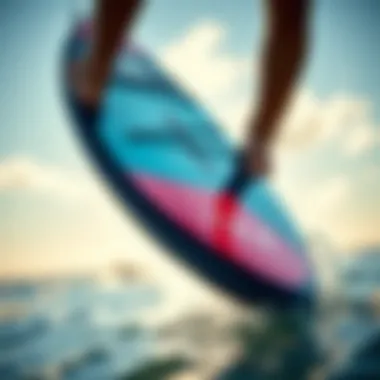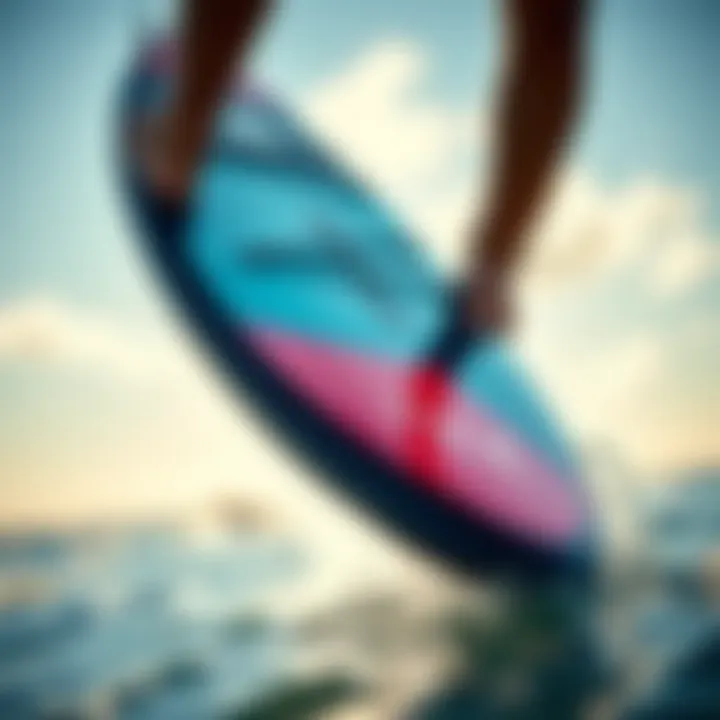Dynamics of Inflatable Foil Boards in Kiteboarding


Intro
Kiteboarding has evolved significantly since its inception, pushing the boundaries of gear design and effectiveness. Among the various innovations, inflatable foil boards stand out for their unique approach to enhancing kiteboarding experiences. These boards merge the buoyancy of inflatable technology with the performance characteristics of foil boards, presenting kiteboarders with an exhilarating alternative.
The journey into the world of inflatable foil boards reveals not just their mechanics but also the deeper impact they have on the sport itself. It’s like discovering a new dimension where the wind and water interact seamlessly underneath you. This article sets out to unravel the specifics of these boards, looking closely at their design features, user benefits, and essential tips for maximizing usage—whether you're just starting out or you're an experienced kiteboarding aficionado.
Gear Insights
Latest Gear Reviews
When diving into the vast ocean of inflatable foil boards, familiarizing oneself with the latest offerings can truly enhance one’s ride. Notable names like Naish and Slingshot have made significant strides in recent years, debuting models that balance performance and ease of use.
- Naish S26 Hover: Known for its responsive design, the Hover offers exceptional stability and maneuverability, a must for both seasoned riders and newcomers. Users rave about its lightweight feel, allowing for quick transitions.
- Slingshot Alien Air: This board distinguishes itself with its unique construction, integrating high-quality materials that provide excellent durability without sacrificing weight. Riders note that it glides smoothly through the water, offering top-notch lift even in lighter winds.
Understanding the latest gear can be the difference between flying high and taking a tumble. Keeping an eye on user feedback and reviews will help you grasp which board suits your needs and riding style.
Essential Gear for Beginners
For those stepping into this thrilling realm, selecting the right gear becomes a cornerstone of success.
- Inflatable Foil Board: Prioritize ease of handling and stability. Look for options that offer good floatation, aiding take-offs and landings. Beginners often find boards with a wider base more forgiving.
- Kite: Ensure you choose the right size based on your weight and wind conditions. A versatile kite can make your learning curve less steep.
- Safety Gear: Never skimp on safety. A good harness, helmet, and impact vest can save you from potential injuries while you master the basics.
Getting these essentials right can drastically improve your learning experience. As they say, "The right tool for the right job".
"Choosing the right inflatable foil board can redefine your kiteboarding experience, transforming your weaknesses into strengths."
Techniques and Tips
Advanced Tricks and Techniques
Once you've gained some experience with inflatable foil boards, it's time to elevate your skills. Tricks such as tacks, jumps, and spins can add flair to your sessions. For instance, mastering the tack requires fine tuning your weight distribution and body shifting, allowing for smooth transitions while maintaining speed.
- Jumping: Start with a solid take off from the foil. As you ascend, keep your body compact but relaxed to control your landing effectively.
- Spins: Practice the basic 180-degree turns before advancing to more complex rotations. Starting slow lets you focus on technique, making future attempts less daunting.
Safety Practices for Kiteboarders
Safety remains paramount in every kiteboarding session. Ensure you follow these basic principles:
- Check Your Gear Before Use: Inspect for any damage that could lead to accidents.
- Understand the Wind Conditions: Always monitor wind speeds and changes to avoid mishaps.
- Be Aware of Surroundings: Stay alert to other kiteboarders and obstacles on the water.
A thorough grasp of safety practices not only protects you but also allows you to enjoy the thrilling aspects of kiteboarding without fear.
Finale
In summary, inflatable foil boards have transformed kiteboarding, offering new dimensions of performance and enjoyment. By exploring the latest gear reviews and essential practices, kiteboarders can maximize their experience on the water. Whether you are just starting or looking to refine your skills, understanding these boards' dynamics can lead to transformative experiences. By systematically aligning gear choice with riding style and safety practices, the kiteboarding community continues to grow, fueled by the excitement of adventure and innovation.
Prolusion to Inflatable Foil Boards
The world of kiteboarding is always on the move, and one of the stellar innovations in recent years is the inflatable foil board. This cutting-edge gear has opened doors for kiteboarders looking to enhance their performance on the water, turning the dynamics of movement and control into a refined art. Such boards represent a significant leap from traditional kiteboarding setups, providing a unique blend of buoyancy and maneuverability.
Inflatable foil boards are particularly important in the kiteboarding scene, catering to both beginners and seasoned riders. They are not just a passing trend; they embody the evolution of kiteboarding equipment itself. For anyone who’s ever found themselves struggling with board stability or wishing for a more intuitive feel on the waves, these boards might just hit the nail on the head. When considering options for one's kiteboarding kit, inflatable foil boards merit attention for several reasons.
Benefits and Considerations
- Portability: One of the obvious advantages is their lightweight and compact nature when deflated. This makes them a traveler’s best friend. You can easily lug them around for those spontaneous kiteboarding trips, whether it’s a journey to the Bahamas or a local spot by the beach.
- Easier Learning Curve: Inflatables tend to be more forgiving, allowing newcomers to find their ground without biting the dust too badly.
- Adaptability: Their design allows for a different riding experience, where a subtle shift in weight can produce dramatic changes in performance. This adaptability can elevate the enjoyment on any water surface.
However, with great innovation comes responsibility. It's vital to understand that these boards have their own quirks. Riders should be aware of the learning curve associated with foil technology and how it interacts with wind and water conditions. Not all inflatable boards are created equal; understanding nuances in design, size, and material can drastically alter the riding experience.
In the sections that follow, we will explore the rich evolution of kiteboarding gear and dive into the technical aspects of foil technology, shedding light on how inflatable foil boards have set themselves apart from traditional foil boards.
Characteristics of Inflatable Foil Boards
Understanding the characteristics of inflatable foil boards is crucial for any kiteboarding enthusiast looking to elevate their experiences on the water. These components not only dictate how a rider interacts with different water conditions, but also influence factors like portability, ease of use, and ultimately, enjoyment. When it comes to inflatable foil boards, three principal elements need to be highlighted: the materials used, size and shape variations, and weight considerations.
Materials Used
The materials that go into fabricating inflatable foil boards play a significant role in their performance and durability. Typically, high-quality boards are crafted from materials like drop-stitch fabric, which is known for its excellent rigidity when inflated, and a sturdy outer layer made from PVC or similar materials that resist abrasion and UV damage.
- Drop-Stitch Fabric: This material facilitates the board's structural integrity even when under pressure. Riders benefit from a solid surface, increasing control during maneuvers.
- PVC Coating: This layer adds water resistance, ensuring the board remains lightweight while also providing protection against incidental scrapes and dings.
These materials not only contribute to performance but also extend the lifespan of inflatable foil boards, making them a wise investment for consistent kiteboarding enthusiasts.


Size and Shape Variations
Size and shape are pivotal elements that customize the riding experience. Inflatable foil boards come in various sizes, catering to different skill levels and riding styles. A shorter board, for example, is easier to maneuver, making it suitable for beginners. Conversely, a longer board provides enhanced stability and is preferred by advanced riders who seek speed and performance.
- Shorter Boards: Often ranging from 4’ to 5’5”, these are nimble and designed for agility. Novice kiteboarders can easily learn new tricks without feeling overwhelmed.
- Longer Boards: Sizes exceeding 6’ come with better upwind performance, which might attract seasoned riders familiar with the wind dynamics.
When it comes to shape, boards may be wider or narrower based on their intended usage. A wider surface supports stability and eases the learning process, while narrower boards typically offer improved performance and speed, ideal for experienced users.
Weight Considerations
Weight is another integral factor for inflatable foil boards. A lighter board allows for easier transport and quicker modifications in speed during riding. Yet, the importance of balancing weight with material durability cannot be understated. Heavy boards can lead to fatigue and diminished performance, especially in windier conditions.
Things to consider include:
- Carrying Weight: Most inflatable foil boards weigh between 6 to 14 kg. Riders focused on travel prefer lighter options as they facilitate easier transportation.
- Performance Weight: While lighter boards provide speed and agility, boards with a bit more weight could offer better stability in turbulent waters, a key consideration for intermediate to advanced riders.
A well-rounded understanding of inflatable foil boards not only enriches your skills but can transform the way you engage with kiteboarding as a whole.
Advantages of Inflatable Foil Boards
Understanding the advantages of inflatable foil boards is crucial, especially for those who take their kiteboarding seriously. These boards, while seemingly straightforward, pack a punch with features designed to enhance the kiteboarding experience. From their ability to stow easily in a car trunk to providing steadiness in rough waters, there is a lot to unpack. Let’s delve deeper into three critical advantages: portability and storage, stability and control, and the learning curve for beginners.
Portability and Storage
One of the standout features of inflatable foil boards is their portability. Unlike traditional rigid boards that require ample storage space and specific transportation methods, inflatable options can be deflated and packed into a compact bag. This convenience means that kiteboarders can easily take their gear anywhere – whether it’s a quick trip to the beach or an adventure to a remote location. Just imagine rolling your board up like a sleeping bag! This ease of transport has opened doors for kiteboarding enthusiasts, making it easier to explore various kiteboarding spots without the hassle of bulky equipment.
But it's not just about getting it from point A to point B. Storage is another feather in the cap of inflatable boards. When everything is said and done, these boards tuck away neatly into closets or even under a bed. For those living in tight spaces, this is a game changer. It truly makes kiteboarding accessible for many who might have previously felt it was out of reach due to storage constraints.
Stability and Control
When out on the water, stability can mean the difference between a thrilling ride and a frustrating fall. Inflatable foil boards are designed to offer a level of stability that is hard to match. The construction and shape generally keep the board buoyant, creating a smoother glide even in choppy conditions. Surfers often find themselves grappling with balance issues, especially when first starting to enhance their skills. Thanks to the added stability of inflatable boards, users can focus on refining their technique rather than struggling to stay upright.
Control is equally important. Many inflatable foil boards allow for adjustments in the foil setup, giving users more command over their ride. By tweaking the placement of the foil, they can achieve different behaviors on the water, which is particularly valuable when learning how to maneuver effectively. This adaptability not only reinforces confidence but also accelerates the learning process.
Learning Curve for Beginners
For those new to kiteboarding, the journey can be daunting. However, inflatable foil boards offer a smoother entry into the sport. The forgiving nature of these boards helps in bridging the gap between sheer novice and proficient rider. If you've ever flopped around like a fish outta water, you’d appreciate a board that offers grace rather than a slapstick performance! Inflatable boards tend to have a broader surface area, which aids in stable positioning, allowing newcomers to gain their footing faster.
Moreover, with their lightweight design, beginners can manage to up and ride without feeling overwhelmed by the weight of the equipment. This fosters a sense of achievement early on, and as anyone who’s ever picked up a new hobby knows, a little win can ignite a passion.
In summary, inflatable foil boards pack in tons of perks that make them a favorite among kiteboarders. Their portability makes them easy to take on trips; their stability fosters confidence and control on the water, and their user-friendly nature caters to those just getting their feet wet. Embracing these boards could very well enhance your overall kiteboarding adventure.
Disadvantages of Inflatable Foil Boards
While inflatable foil boards bring many advantages, it's essential to delve into their disadvantages to provide kiteboarders with a balanced perspective. Understanding the limitations and challenges associated with these boards can help make informed choices, especially for those who are ready to invest in their kiteboarding experience.
Performance Limitations
One primary concern with inflatable foil boards is their performance limitations compared to rigid foil boards. Many seasoned riders note that inflatable boards tend to be less responsive, especially in demanding conditions. The flex and shape of an inflatable board can hinder sharp turns and quick maneuvers. This limitation often leads to a less exhilarating experience for advanced riders looking for high-speed performance or complex tricks.
Additionally, while inflatable boards excel in stability, their buoyancy might lead to a feeling of being disconnected from the water. This sensation can be disorienting for those accustomed to the more direct feedback provided by traditional boards.
Kiteboarders should also consider that inflatable boards typically have a slower speed threshold. Influenced by factors such as weight and material, some riders find it necessary to exert more effort to achieve significant speeds compared to their rigid counterparts.
Repair and Maintenance Challenges
Another critical aspect that users need to keep in mind is the repair and maintenance challenges associated with inflatable foil boards. While they are designed to withstand various impacts and conditions, punctures and leaks can happen, especially when riding over rough waters or rocky areas. This type of board often requires careful handling; one mishap can lead to costly repairs or even an entire replacement.
To fix a breach, riders must know how to patch vinyl or other materials used in the board’s construction. Getting it wrong can lead to more significant issues down the line. Additionally, the maintenance routine for inflatable boards is often more intensive. After use, thorough rinsing and drying are essential to prevent any unwanted mold or damage, yet many boards may need special care due to the materials involved.
"While inflatable foil boards can enhance the kiteboarding experience, recognizing their drawbacks, such as limited performance and potential maintenance issues, is crucial for making the right choice on the water."
By understanding these limitations and how they can impact the overall experience, kiteboarders—whether beginners or experienced—can better align their expectations with the performance capabilities of inflatable foil boards. The knowledge of repair, maintenance, and performance can lead to more informed choices and a more gratifying time on the water.
Comparative Analysis with Rigid Foil Boards
When diving into the world of inflatable foil boards, an essential aspect is comparing them with their rigid counterparts. This analysis is crucial since it sheds light on various factors influencing performance and rider preferences. The cost of entry into kiteboarding depends greatly on gear selection, and understanding the nuances between inflatable and rigid boards can assist enthusiasts in making more informed decisions.
Performance Metrics
Performance metrics provide a solid ground for comparing inflatable and rigid foil boards. Five main metrics are often considered:
- Speed and Agility: Rigid foil boards typically offer better speed due to their solid structure, which allows for more efficient energy transfer. Inflatable boards, however, can still reach impressive speeds, particularly when conditions are optimal.
- Lift and Stability: In terms of lift, rigid boards tend to excel, especially in choppy water. Their design allows for more precise control, helping riders maintain balance. Conversely, inflatable boards present a unique stability advantage due to their buoyancy, benefiting those who are just starting out or those wanting to ride in various conditions.
- Durability: While rigid boards can suffer from dings and scratches, inflatable boards tend to be more resistant to impacts like collisions with rocks or shallow waters. This aspect is a significant plus for kiteboarders who often find themselves exploring rougher environments.
- Weight: The weight of the board plays a pivotal role in a rider’s experience. Inflatable boards are lighter, making them easy to carry and transport. Those who plan outings that involve traveling will appreciate the convenience that lighter boards bring. Rigid boards, while sometimes heavier, can deliver a more dynamic experience once in play.
- Ease of Use: For novices or those still honing their skills, inflatable boards could be the better choice. Their forgiving nature and ability to float make mistakes less consequential, which can be a confidence booster on the water.


User Preferences and Experiences
User preferences vary significantly when it comes to inflatable and rigid foil boards. Some physique riders lean towards the stability and gentler learning curve provided by inflatable boards, finding them particularly accommodating in their formative experiences.
On platforms like Reddit, many users share their personal anecdotes that highlight the pros and cons of both options. For example:
"I got my inflatable foil board, and it was a game changer! Felt more secure in the water, and I learned to fly quicker than I thought."
Others insist that rigid boards suit their ambition for speed and performance:
"I love my rigid board. There's just no match for the speed you can achieve! It's challenging but so rewarding once you get the hang of it."
A common thread among users of both board types is the need for adaptability. Depending on conditions—be they calm or gusty—having both board varieties may be beneficial, allowing riders to switch up their gear according to the situation. In the end, the choice might come down to personal preference colored by riding style and skill level.
In summary, the comparison between inflatable and rigid foil boards reveals much about cubic yards of foil design, construction, and rider experience. Whether one opts for the ease and safety of inflatables or the speed and control of rigid boards, understanding these dynamics will enhance the kiteboarding experience. Ultimately, the right board can turn an average session into an exhilarating adventure that keeps the kiteboarding spirit alive.
Inflatable Foil Board Setup and Preparation
Setting up and preparing an inflatable foil board is the backbone of a successful kiteboarding experience. This stage can greatly impact the performance of the board in the water and the overall enjoyment of the ride. The setup procedure is crucial, not only for beginners grasping the fundamentals but also for seasoned riders who seek to optimize their sessions.
Understanding the nuances of valve systems, the correct inflation process, and the role of safety checks can be the difference between a smooth glide across the waves and a frustrating day on the water. Moreover, there’s a satisfaction that comes with doing it right—knowing you've set up everything correctly allows kiteboarders to focus on what really matters: the ride.
Assembly Guidelines
Proper assembly of an inflatable foil board is akin to laying the groundwork for a solid structure. Here are key steps to consider when putting your gear together:
- Inspect the Gear: Always take a moment to check your board, foil, and kite for any wear or damage before starting. This precaution can save time and headaches later.
- Choose the Right Location: Set up your gear on a flat, sandy area that’s away from sharp objects. Don’t want to risk any punctures before you even hit the water!
- Inflate the Board: Using an appropriate pump, inflate the board to the recommended pressure, usually indicated on a sticker or label. Over or under-inflating can lead to instability on the water.
- Attach the Foil: Align the foil with the designated mounting points on the board. Secure it properly, ensuring there’s no wobbly feeling. A tight fit is essential for performance.
- Connect the Lines: Attach your lines to the kite. Ensuring that the lines are free of twists is key. A tangle could lead to a frustrating situation once airborne.
- Final Checks: Before heading to the water, conduct a final inspection. This last-minute check can catch overlooked issues that could impact your ride.
A well-set board can feel like an extension of oneself, allowing for a fluid experience on the water.
Essential Gear for Optimal Performance
The setup is just one part of the equation; having the right gear enhances the overall kiteboarding experience. Below is the essential equipment that can lead to optimal performance:
- High-Quality Pump: A reliable pump with pressure gauge ensures that your board is inflated exactly how it needs to be.
- Safety Leash: Always attach a safety leash to prevent losing your board in case of a mishap.
- Comfortable Harness: A proper harness distributes the weight evenly and allows for maximum control without discomfort.
- Wetsuit: Protects against cold water and abrasions, while also providing buoyancy.
- Helmet and Impact Vest: Particularly important for beginners or those trying new tricks, these can safeguard against falls and impacts.
Keeping this gear handy not only enhances your performance but boosts your confidence as you navigate through the water.
"Preparation is the key to success. In kiteboarding, every detail matters; skipping just one step could change your whole day on the water."
Ultimately, the setup and preparation phase is rooted in establishing a solid foundation for both safety and performance. Each element ties back together to provide a comprehensive experience that can transform how you perceive kiteboarding.
For more detailed guidelines on kiteboarding gear and techniques, consider checking resources like Wikipedia or forums on Reddit. Understanding the importance of your gear setup could yield far better adventures out on the water.
Safety Considerations While Using Inflatable Foil Boards
When it comes to kiteboarding, safety should always be a top priority, and inflatable foil boards are no exception. While these boards can enhance the riding experience, there are certain risks and precautions that users must be aware of. Understanding safety elements is fundamental to enjoying this thrilling sport without putting yourself in potential danger. This section highlights essential aspects of safety, emphasizing both personal well-being and environmental respect, vital for kiteboarders of every skill level.
Personal Safety Equipment
When setting out to kiteboard with inflatable foil boards, wearing the right personal safety equipment is critical. Here’s what you should consider:
- Wetsuits or Dry Suits: Depending on your location and the water temperature, a wetsuit can protect you from the cold and any potential scrapes. Dry suits offer even more protection by keeping you completely dry.
- Impact Vests: This equipment is specifically designed to cushion impacts during crashes, which can happen from time to time, even when you're doing your best to maintain control. An impact vest can mitigate injuries during such events.
- Helmets: A helmet is crucial while kiteboarding, especially for beginners. A good helmet can protect your head from unexpected falls, collisions with your own gear, or rogue kites that might stray into your vicinity.
Adding to your safety gear, it’s wise to ensure you have a leading-edge inflatable kite with safety releases and a leash. This equipment, when used correctly, can greatly reduce risks associated with kiteboarding.
"Safety first is safety always." — Charles M. Hayes
Investing in high-quality gear is just as important as knowing how to use it. Make sure to check the suitability of your equipment for the conditions, and always perform a pre-ride inspection.
Environmental Awareness
While enjoying the waves, acknowledging environmental factors is paramount. Kiteboarding with inflatable foil boards can impact marine life and ecosystems, so being aware is not just for your safety, it's a responsibility. Here are some considerations:
- Respect Wildlife: Many areas are home to sensitive species. Keeping a respectful distance from wildlife can prevent potential harm to both the creatures and your riding experience. Be mindful of nesting birds or marine mammals, especially in coastal areas.
- Know the Local Regulations: Different regions have specific rules regarding where you can kiteboard. Always check local regulations, and follow any guidelines designed to protect both the environment and other water users. Factors like no-wake zones and protected habitats must be adhered to.
- Pick Up After Yourself: Be a conscientious adventurer. Carry out any trash you encounter during your outings and leave beaches cleaner than you found them. This not only helps the environment but also sets a good precedent for fellow kiteboarders.
Paying attention to the ecosystem and behaving responsibly can lead to a better future for us all, preserving kiteboarding locations for future generations to enjoy. Remember, the thrill of riding on the water comes with the duty to protect it.
Kiteboarding Locations Suited for Inflatable Foil Boards
When considering inflatable foil boards, it’s crucial to look at where you plan to ride them. The locale can greatly influence your experience and performance. Ideal kiteboarding locations not only offer a steady wind but also have water conditions that suit the unique characteristics of inflatable foil boards. These boards thrive in conditions where stability and smooth transitions between water and air are paramount.
Inflatable foil boards shine when the environment is right; they glide smoothly on the surface and can lift off easily with just a bit of wind. In essence, knowing where to go makes all the difference, particularly for novice riders or those looking to master their craft.


Top Global Destinations
Here are some prime spots around the globe that cater exceptionally well to inflatable foil board enthusiasts:
- Hood River, Oregon: Known for its constant winds and breathtaking scenery, Hood River is a mecca for kiteboarders. The Columbia River provides both flat water and waves; ideal for varied skill levels.
- Tarifa, Spain: If you’re after consistent wind and an eclectic atmosphere, Tarifa is the place. It’s renowned for its strong, steady breezes which make it a favorite among advanced kiteboarders.
- Cumbuco, Brazil: This paradise boasts warm water, consistent winds, and a welcoming local community. The flat waters of the lagoons are particularly appealing for those practicing their skills or tricks.
- Maui, Hawaii: With stunning backdrops and reliable trade winds, Maui has unlimited possibilities for all kite enthusiasts. The southwest shore’s consistent wind is perfect for inflatable foils, but be mindful of the learning curves with waves.
These locations are not just about good conditions; they also often come with established communities. Finding fellow riders and learning from locals can truly enhance your experience.
Local Insights and Conditions
Understanding the local conditions is vital for making the most of your inflatable foil board experience. Each destination will have its own set of challenges and benefits:
- Wind Patterns: Before heading out, it helps to be aware of the typical wind patterns. For instance, Hood River experiences strong afternoon winds, while Tarifa may see bursts throughout the day.
- Water Conditions: The surface type matters. Flat water is generally best for beginners, while more experienced riders might appreciate the challenge of waves. For example, Cumbuco’s lagoons provide a perfect flat area to practice without disturbances.
- Seasonality: Some places, like Maui, have a specific kiteboarding season where conditions are at their peak. Learn these peak times to plan your visits accordingly to ensure you're hitting the water during the best conditions.
- Local Regulations: It's prudent to familiarize yourself with local rules where you wish to kiteboard. Each area could have specific restrictions related to equipment, launch sites, etc. For example, some beaches may require a permit for launching.
In summary, knowing the right locations and understanding their unique conditions not only enhances comfort and enjoyment but can substantially impact your growth as a kiteboarder. With the combination of a fitting board and a suitable place to ride, you'll be set to fully enjoy the dynamics of inflatable foil boards.
User Testimonials and Experiences
Understanding the user testimonials and experiences surrounding inflatable foil boards is pivotal in grasping their impact and effectiveness in the kiteboarding scene. These insights not only offer firsthand accounts from diverse skill levels but also highlight the practicalities and real-world advantages or struggles that enthusiasts encounter. Potential buyers, whether they be seasoned riders or fresh faces in the sport, benefit tremendously from this pool of shared narratives. In addition to technical specifications, personal stories create a vivid picture of how these boards interact with different conditions, techniques, and individual preferences.
Beginner Stories
Picture this: a novice kiteboarder, Alex, eager to feel the thrill, steps onto an inflatable foil board for the first time. "I thought it would be easy after watching some videos online—that was a rookie mistake," Alex laughs, reflecting on his early days. He recalls the initial instability and the countless tumbles into the water, which could have easily discouraged him. However, what kept him going was the freedom and smooth feeling he experienced once he got the hang of it.
Alex points out how inflatable foil boards are forgiving when learning how to balance and move with the kite. The wider surface area and buoyancy offered by these boards played a crucial role in his learning curve. He mentions, "I felt more in control and less likely to wipe out completely, which gave me the confidence to keep trying."
This sentiment is echoed by others who found their footing through similar experiences. Many beginners appreciate the accessibility that inflatable foil boards provide. They mention how the ease of carrying the equipment and setting it up allows for more time on the water. Local kiteboarding schools often recommend this type of board to their students, showcasing their advantages while easing the nerves that often accompany first-time experiences.
Expert Insights
Transitioning to experienced riders, let’s consider Casey, who has spent years refining her skills on various types of boards. "Inflatable foil boards are a game changer in terms of performance and versatility," she asserts. Casey elaborates on how the development in materials and technology has significantly enhanced the riding experience. She often rides in different conditions—from choppy waters to flat surfaces—and notes how the inflatable foil board consistently delivers a stable and responsive ride.
In her view, the ability to pump these boards up to different pressures allows for customization based on the wind and water conditions. "You can tweak the pressure slightly to alter the ride's feel, which is not something you get so easily with rigid boards," she remarks.
Furthermore, many advanced riders emphasize the fun factor. They share their stories of being able to ride longer distances with less effort due to the lift provided by the foil. The ability to ride in lighter winds while maintaining speed allows them to explore more remote or pristine kiteboarding locations.
"Inflatable foil boards have expanded my horizons. I can ride places I never thought I’d be able to!" - Casey, Expert Kiteboarder
Overall, the mix of beginner and expert testimonials paints a comprehensive picture of the inflatable foil board experience in kiteboarding. These narratives serve not just as guidance but also encourage a community dialogue, shaping the ongoing evolution and appreciation of this exciting sport. Updated developments, coupled with peer insights, will continue enhancing the popularity and accessibility of inflatable foil boards for all levels.
Future Trends in Inflatable Foil Board Design
The winds of change are constantly blowing in the world of kiteboarding, and inflatable foil boards are no exception. As technology advances and rider preferences evolve, designers are leaning toward innovations that promise not just improved performance but also user-friendly features. This exploration of future trends in inflatable foil board design provides insight into key areas of focus, such as efficiency, versatility, and environmental responsibility, which are reshaping the landscape for adventurers and enthusiasts alike.
Innovations on the Horizon
In the realm of inflatable foil boards, innovation isn’t just a buzzword; it’s the lifeblood that keeps the sport thrilling and fresh. The next wave of design is geared towards enhancing aerodynamic efficiency—foils shaped with precision will allow for smoother rides and greater lift in lighter winds. Riders might soon see designs that incorporate advanced hydrodynamics, resembling nature-inspired structures that minimize drag while maximizing speed.
One notable advancement includes the integration of smart materials that respond to varying conditions on the fly. Imagine boards equipped with sensors that can communicate with your kite to adjust balance and tension, leading to an adaptive riding experience that can handle any gust. Not to mention, these boards may become lighter yet sturdier, a delicate balance that manufacturers are diligently working towards.
- Key Innovations Expected:
- Smart Sensor Technology: Enhancing real-time adjustments for optimal performance.
- Streamlined Shapes: Drawing from biomimicry for efficiency.
- Advanced Materials: Lightweight composites that combine durability with flexibility.
As designers continue to push the envelope on inflatable foil board technology, it’s essential for kiteboarders to stay abreast of these developments, ensuring they have the tools that unlock their potential on the water.
Sustainability and Eco-Friendly Materials
Sustainability has become a pressing concern across all industries, and kiteboarding is no different. The next phase of inflatable foil board design will critically involve eco-friendly practices and materials. Boards crafted from recycled plastics and renewable resources are slowly creeping into the market. These materials not only reduce the carbon footprint but also ensure that the joy of kiteboarding can be enjoyed by future generations without detrimental environmental impact.
The shift towards sustainability doesn’t stop at materials. It encompasses the entire lifecycle of a product, from production to disposal. Designers are looking at making boards that are easier to repair and recycle once they reach the end of their life. New manufacturing processes promise to minimize waste, drawing inspiration from circular economy principles.
- Considerations for Sustainability:
- Materials: Biodegradable and recycled options.
- Production: Eco-conscious manufacturing practices that generate less waste.
- End-of-Life: Boards designed for easy repair and recyclability.
End
As we reach the end of this exploration of inflatable foil boards within the kiteboarding world, it's clear that these innovations hold significant value for both newcomers and seasoned riders. The importance of understanding inflatable foil boards cannot be overstated; they represent a shift in how enthusiasts experience kiteboarding. With their unique blend of portability and performance, inflatable foil boards have changed the game, making the sport more accessible while enhancing the riding experience.
Key Takeaways
- Portability: Inflatable foil boards can be deflated and packed away easily, allowing for hassle-free travel. This feature is particularly appealing to those who often explore various kiteboarding locations, whether domestically or abroad.
- User-Friendly Design: Many riders note that inflatable models offer a gentler learning curve, making them suitable for beginners while still catering to the more experienced crowd seeking versatility.
- Stability: The construction of these boards provides an excellent balance on the water, allowing for smoother rides in varying conditions. This stability can boost confidence in newcomers and improve technique in advanced users.
Final Thoughts on Inflatable Foil Boards
"Modern kiteboarding gear, especially inflatable foil boards, can act as a bridge; connecting traditional kiteboarding with cutting-edge technology, enhancing the experience significantly."
By embracing these dynamic boards, kiteboarding enthusiasts can not only elevate their skills but also gain a deeper appreciation for the sport. The journey through the waves with an inflatable foil board is not just about riding—it's about embracing the freedom and fluidity that stem from a well-crafted piece of equipment.















